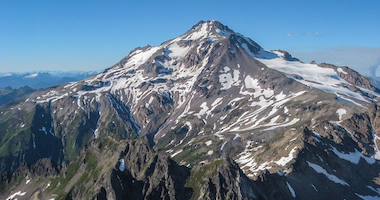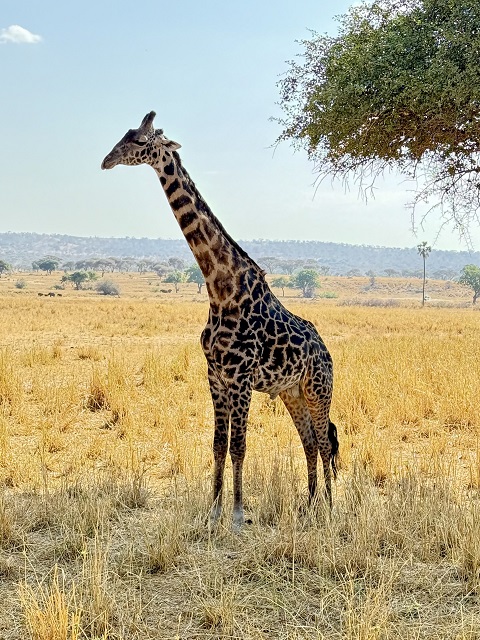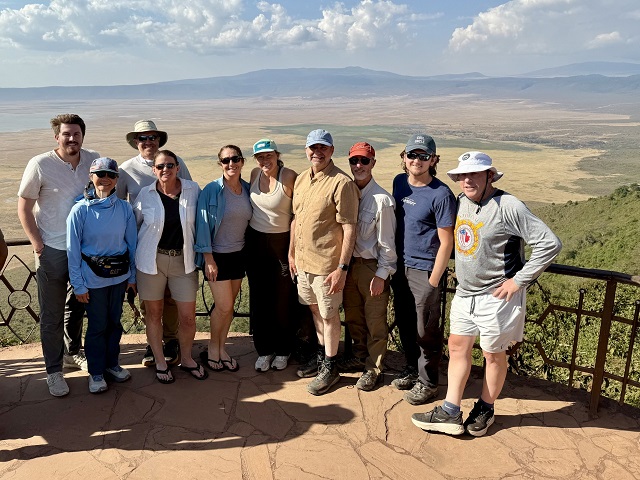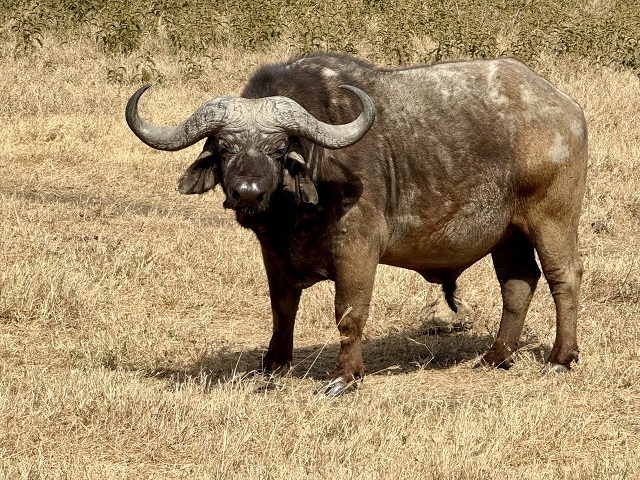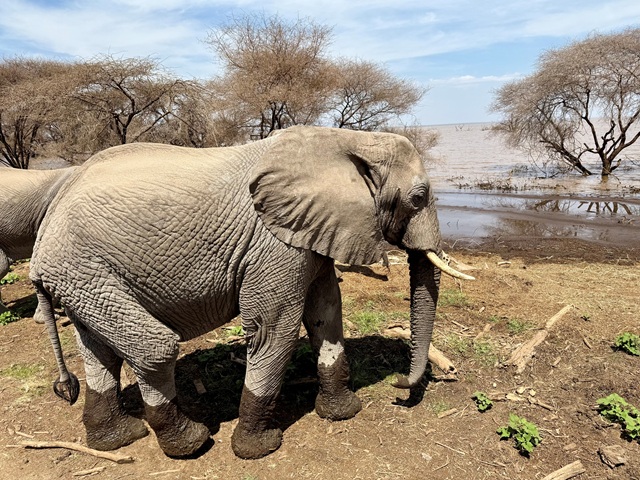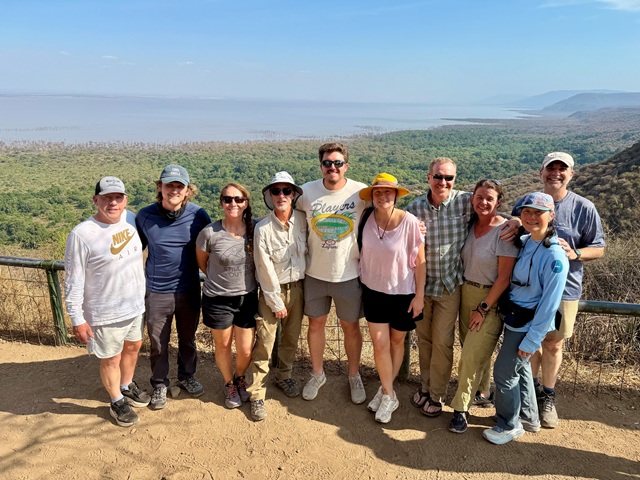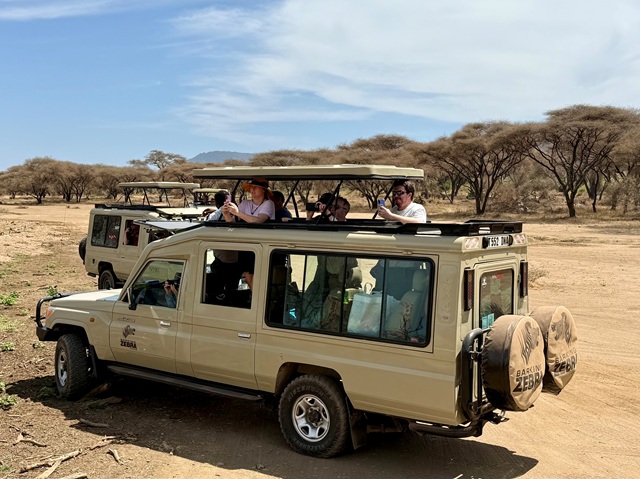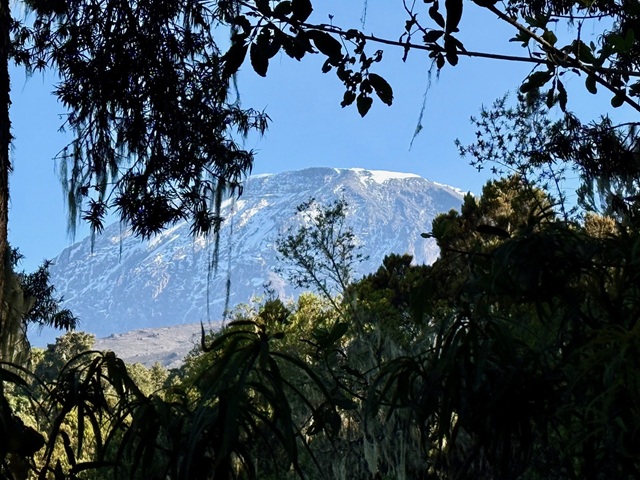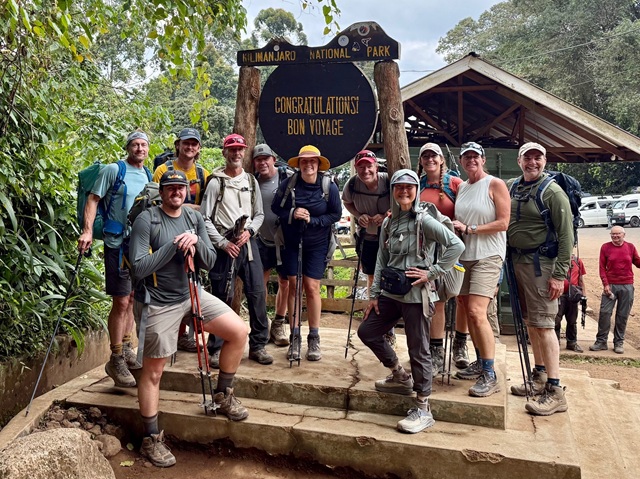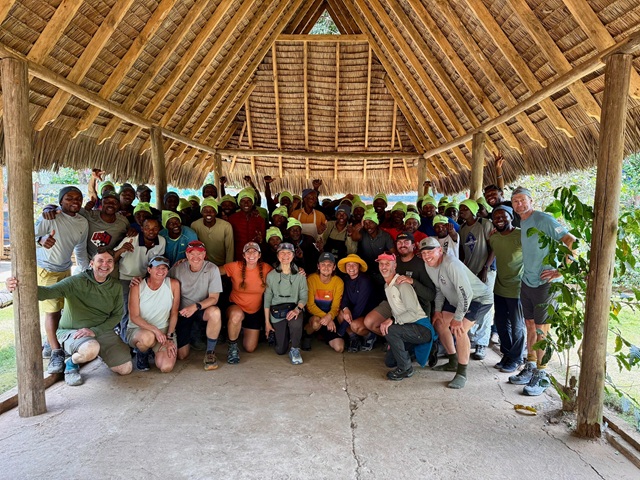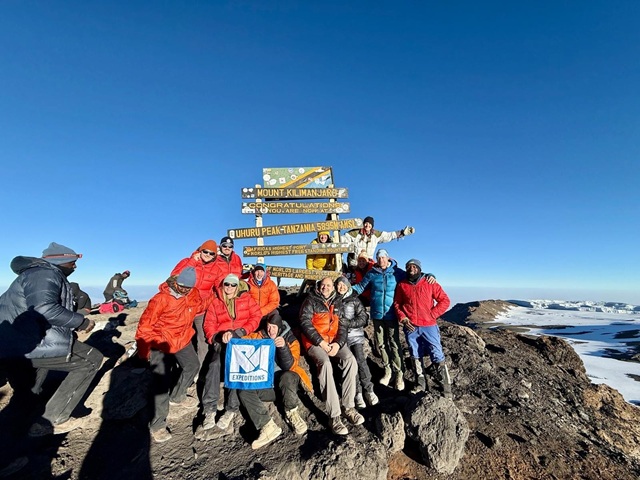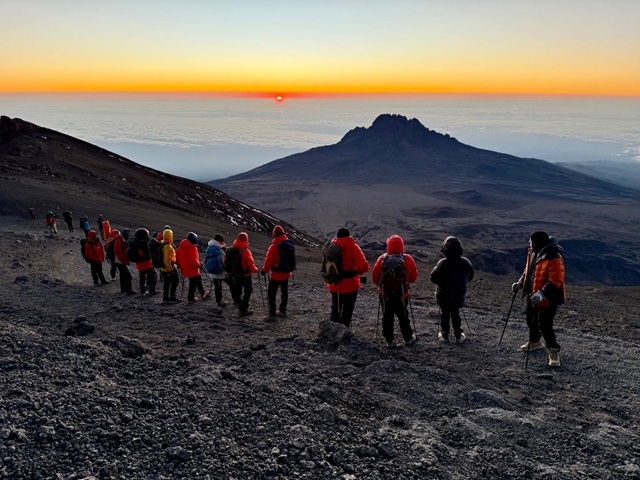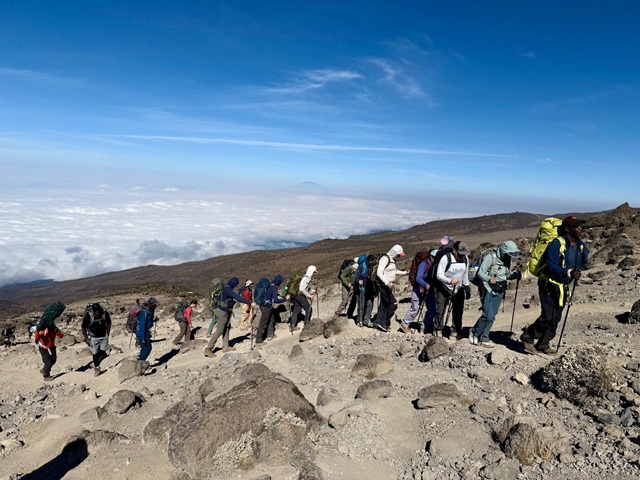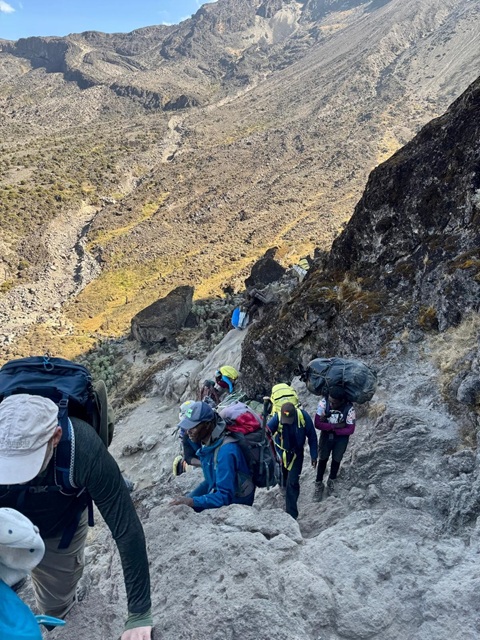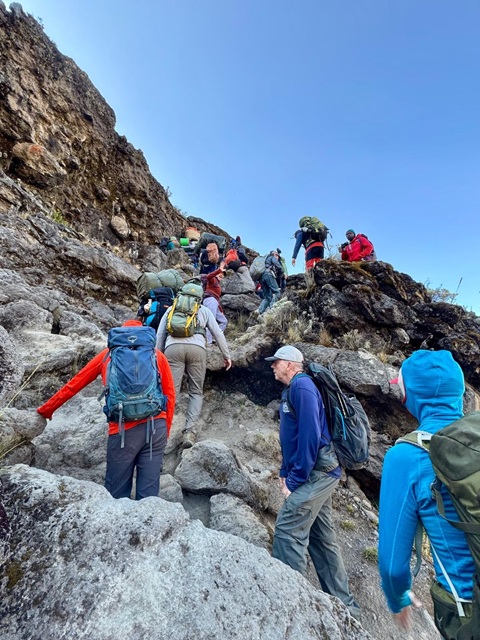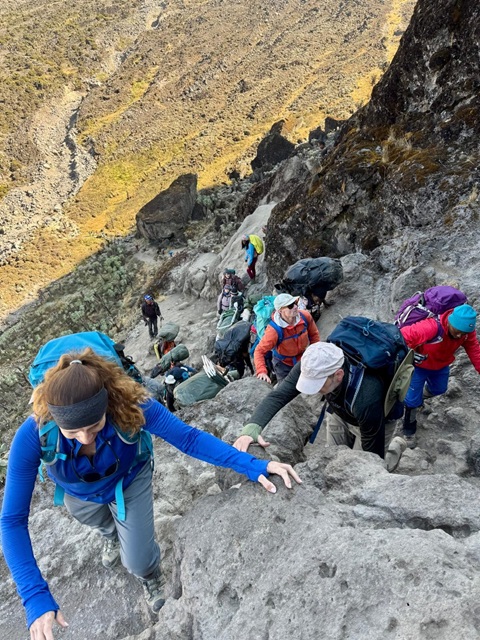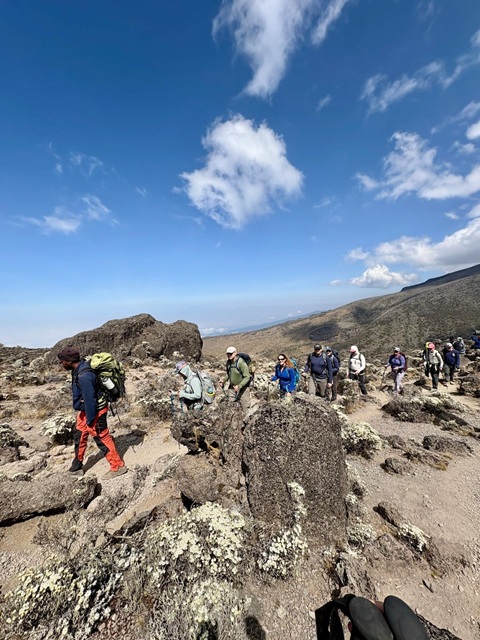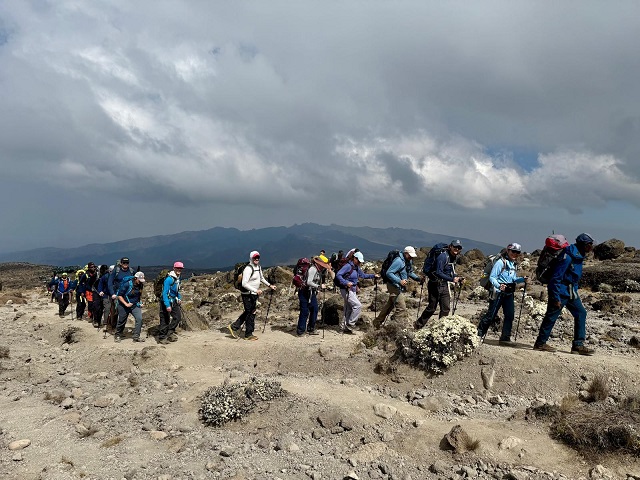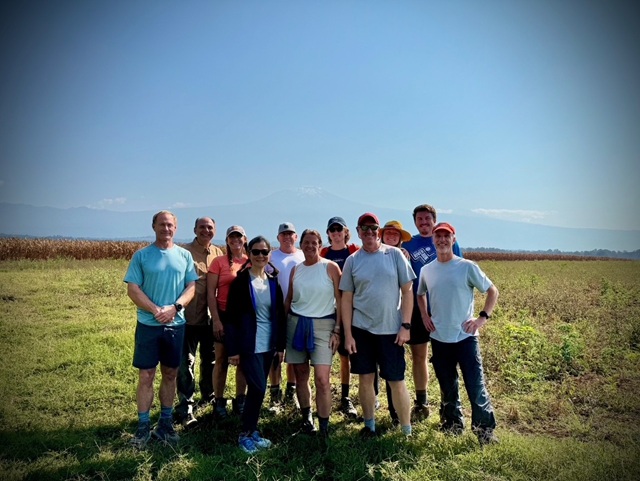Entries from Expedition Dispatches


It was plenty cold at low camp last night. Namgya bravely got out of the tent at 11 AM to fire up the stoves, even though we were still in the cold shadow. The weather held, with little cloud cover getting in our way. We watched a blanket of thick cloud fill the valley below and we could see wind tearing at the mountaintops, but we lucked out with calm and sunny conditions for our five hour and ten minute climb up to high camp.
Willie Benegas and Vern Tejas managed to get their teams to the summit deespite the winds and both were back just after we got our tents built and kitchen dug out, around 8:30 PM. Vern is the new world's record holder for Vinson ascents, with 27. I have a chance to tie him tomorrow if the weather cooperates and if my climbers are feeling fine. They seem to be. Leif Whittaker, who turned 25 the day we flew out of Punta Arenas, is cruising along as if he did this sort of thing all the time. One can't help just assuming that it is in his blood, since his Dad is Big Jim Whittaker -the first American up Everest. Sashko Kedev, our cardiologist from Macedonia was thrilled with the day on the ropes today and obviously can't wait for tomorrow. Tim Amos, our producer from New York City, has been strong and steady all along. Brent Huntsman is the team geologist from Ohio and when we slow down enough to permit conversation (not often), he explains the wild "chevron" folds in the rock we are seeing.
It is calm now (12:30 AM) at high camp, we want it to stay that way.
We paused for a rest today. It turned out that our hard work of the past few days had acted to bring back a chest cold that poor John thought he was done with. While he didn't seem greatly incapacitated by it, we decided that it was the sort of thing that would get worse by going higher and colder. We chose instead to get John lower and warmer. Namgya and I brought him down to bascamp where ALE's staff graciously agreed to look after him until we get down from our summit bid. Meanwhile, Leif, Sashko, Tim and Brent rested and rehydrated at low camp, enjoying a lunch of quesadillas and aji sauce. Namgya and I cruised back up in a businesslike 2 hrs, rejoining the gang in time for a late dinner in the strong sunshine. It was still brilliantly clear except for some sculpted wave clouds forming and fading on the high peaks. The word from up above was that it was cold and windy. Even so, Scott made the summit with his climbers. Vern and Willie chose to rest their teams at high camp for the day. We are hoping for a drop in winds tomorrow and a green light for moving up.


It is 1:30 AM, the sun is still shining brightly out and I've just crawled in the tent. It has been a long day -in lots of good ways. Once the sun runs into the western rib of Vinson at around 3 AM, we don't get it again until 11:30. That is the downside of being so close in to the massive west wall of Vinson, but there are upsides. We get an incredible view of this 2,000 meter face of rock and snow with its three immense ice strreams tumbling downward in the slowest of motion. We climbed the northern end of the wall today, carrying a load of supplies up a thousnd meters or so to high camp. A snowstorm had been forecast, but instead we got nothing but intense sun and a giant blue sky. It was literally the perect day for climbing in Antarctica. Most of our day was spent working up a long section of fixed rope. Before we'd gone very far up the steep snow we were treated to unlimited views out to the west. Ice, ice and more ice... Way out to the horizon where it usually gets tough to tell the divide between Earth and sky. It took us six and a half hours to get up to high camp, which we reached at 8 pm (we don't do early starts in such a cold place when camp is in shadow) and we were back down at low camp again by 10:30. Dinner was a welcome chance to sit around and talk over the roar of our stoves. It does take hours to melt all of the snow we require for water after such a long day out.
Tomorrow we may move up to high camp, or we may rest for a day... It depends on how strong the gang looks at our 11:30 breakfast, and on whether that snowstorm finds us.
This is the Aconcagua team checking in from Camp 1. Last night we got more snow at Basecamp, not too much, but enough to get the camp completely white when we left this morning. The landscape was unique so we didn't miss the opportunity to take lot of pictures. The group did a great job climbing to C1 today, it took us 4:30hs to get here and everybody is feeling strong. Right now we have started the stoves and will enjoy a nice dinner with vegetarian couscous in a little bit.
Our plan for tomorrow is to carry to our Camp 2 (also known as Campo Lama, because of the remains of a helicopter Lama that crashed there a long time ago).
We hope that everybody there is enjoying the progress of our team, we will keep sending updates!


We accomplished our move up from basecamp in fine style today. Within the first thirty minutes on the track, we burst out of a low cloud layer into brilliant sunshine and the bluest of skies. All seemed to be feeling strong and as our loads were lighter than on yesterday's carry, we cranked up the pace a notch. We cruised in to camp in just over 4 hrs. Namgya Sherpa led a rope with Tim Amos and Leif Whittaker. I tied in with John Kelly, Brent Huntsman and Sashko Kedev. I enjoyed chatting with Namgya at our rest breaks. He has climbed Everest 9 times along with ascents of Cho Oyu, Dhalagiri and Shishipangma. When I thought about those numbers a bit, I realized something peculiar about the approximately 25 climbers that make up Vinson's current population. I've got eleven, Willie Benegas and Vern Tejas have about nine Everest summits each, together with a healthy handful by guides Scott Wollums, Michael Horst and David Hamilton... Throw in a few more for the clients on our teams who have been up (like Sashko on our team) and the grand total must be up near sixty. But none of that will be very comforting if we can't manage to climb Vinson in the coming days. Luckily for us, Namgya has already been up Vinson three times this season and knows the way. He is from the eastern part of Nepal, near Kangchenjunga, but these days lives part of each year in Kathmandu, part in Cambridge, England and part in Antarctica.
The other teams on the mountain have spread out a bit, with some now at high camp, some having carried high and with ourselves bringing up the rear. Fine with us, that way. Today was a classic antarctic climbing day. The air temperature probably didn't pass 5 degrees F, but with intense sun reflected off extremely clean white snows, the apparent temperature was downright Carribean. We were treated to splendid views of the big and steep mountains to the north which are seldom climbed. Shinn, Epperly and Gardiner are massive and formidable and don't exactly beckon to those of moderate skill (we couldn't see Tyree today, but it is even more massive and more formidable and does even less beckoning).
We enjoyed a fine dinner in our new home and turned in, tying everything down in case of storm... such a thing is difficult to imagine just now as there isn't a hint of wind and the midnight sun continues to blaze away in the summer sky. It will get intensely cold in a few hours when the sun ducks behind Vinson... But as I say, who wants to think about that now?



Good weather today and perfect route conditions. We carried a load of food, fuel and gear to "low camp" and then returned -as planned- to VBC. Five and a half hours up, about thirty minutes to cache the gear and bask in the high altitude sun and then two and a half hours down. All did well, all are cheerful... More tomorrow.
Today we carried to Camp 1 (16,400'). It took 4:30hs to get there and 2hs to get back to basecamp. Everybody did great work carrying the loads (food, fuel and some personal gear). This evening the mountain offered us a nice surprise, it snowed 1 or 2 inches so now the mountain looks brown and white, beautiful views!
Tomorrow we will rest and prepare for our move to Camp 1 the next day.
We will continue updating.

A moderately stormy day on Mount Vinson. We chose not to do our intended carry because of persistent wind and cloud, which when combined with the normal cold temperatures makes travel a little dicey. Or at least a little more dicey than we hoped for for our intro to the mountain. Instead we practiced a bit with our avalanche beacons, beefed up the snow walls around our dining tent and went for a three- hour hike with light packs when conditions improved slightly in the afternoon. Forecasts call for less wind tomorrow and we'll hope to take advantage.




Just a brief note for now. It is almost midnight and these last couple of days have been quite busy... But we are finally right where we want to be, after a lot of flying and a lot of packing and preparing.
It didn't look so likely yesterday as we hung out in Punta Arenas. I took the gang up to the office of our logistics company ALE and Peter MacDowell was nice enough to give a tour and to explain just what lengths the company goes to in order to figure out flying weather in Antarctica. Winds at that time were still blowing too hard for a flight in. But as the afternoon progressed, things started to seem a bit more positive. At 7:30 we got the call to get ready in a hurry... Things were happening. We hustled out to the airport in our polar clothes... Waddled through security and onto our plane. The kazak crew politely directed us and we blasted out of Punta at 10 pm sharp. Four hours later the big jet roared to a stop on the blue ice runway at patriot hills and the tail lifted to offload tons of gear, food, fuel and machinery. And us. We got out snapping pictures of the 2 am sunshine and ice stretching as far as the eye could see. It was cold, but not unpleasantly so, since the wind had quit entirely. We walked the kilometer to Patriot Hills camp, enjoyed a fine bowl of beef stew (the traditional welcome in these parts) and then went out into the cold again to get our own tents built. At 5 am in the bright sunshine we went to bed. My head was spinning from seeing so many old friends among the camp staff and the climbers that were outbound on our jet. My old kiwi pal Sean Norman woke us at 9:30 to get us ripping down our tents. Time to fly again... This time in a Canadian twin otter on skis, to vinson. The flight through the Ellsworths took about an hour, the weather was fine and we landed at full power going uphill on the Branscomb. The day was then spent building another camp, getting a climbing kitchen going and sorting gear for a day of climbing tomorrow. Michael Horst and Vern Tejas are next door with their team, Willie Benegas is a few feet the other way with his. Scott Woolums is guiding a few folks as well. My team got to meet Namgya Sherpa who will be working with me. He came down in mid afternoon today from summitting Mount Shinn yesterday (Shinn is third highest in Antarctica).
It is calm and still at VBC as is often the case, but in the last hour or so it has gotten murky and misty and light dry snow is coming down while the temperature hovers around -10 F. Everybody is in bed now, deep in warm down sleeping bags.
Posted by:
Categories: Expedition Dispatches Aconcagua
This is the RMI team checking from Plaza Argentina.
Today we had a beautiful day, weather was nicer than yesterday (no wind) and everybody arrived at basecamp in great style. At our new home here at Plaza Argentina, we settled in, setting camp and saying goodbye to our mules who have carried the bulk of our gear to basecamp. After a long day that we started very early, waking up at 5:45, we had a succulent stew and went to bed early to recover from our long day. Tomorrow we will rest and work on the food and gear that we will be carrying to Camp 1 the next day.
Now at 21:30 the night's calm, something that didn't happened yesterday. According to descending climbers we passed along the trail, high winds hit basecamp, damaging tents and reminding us that here in the Andes we have to be prepared and do a good job setting camp. We will be reporting more news from Plaza Argentina.
Previous Page
Next Page



